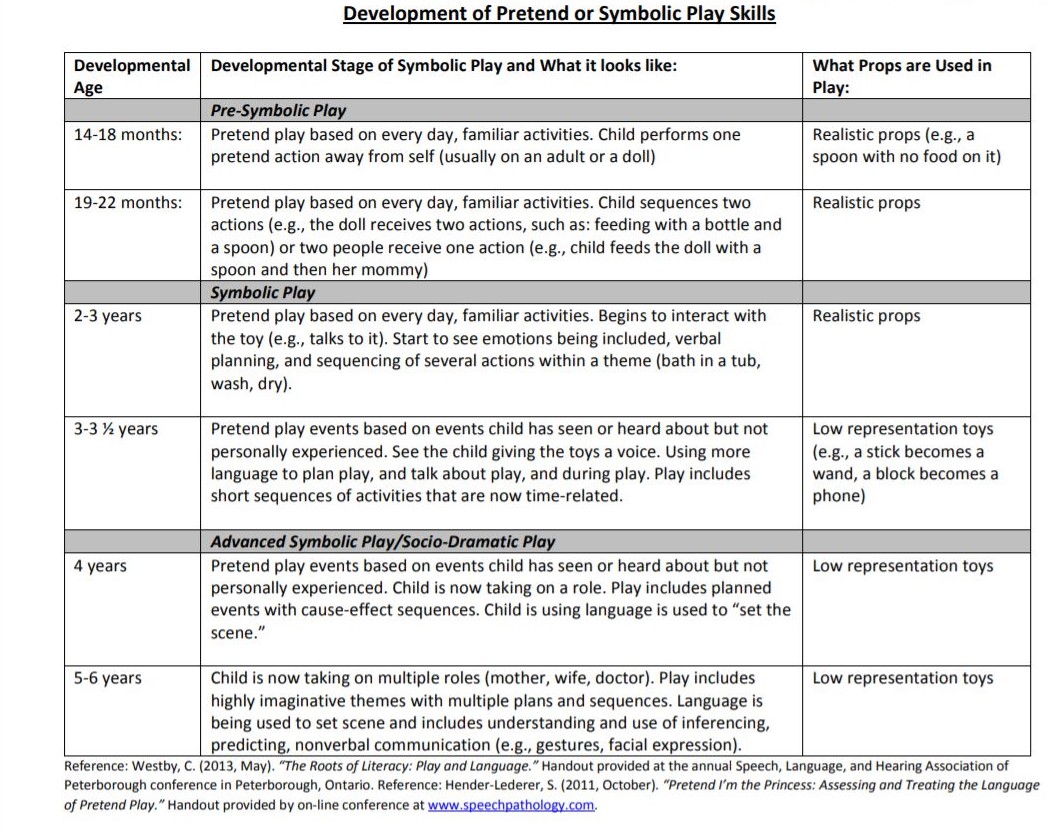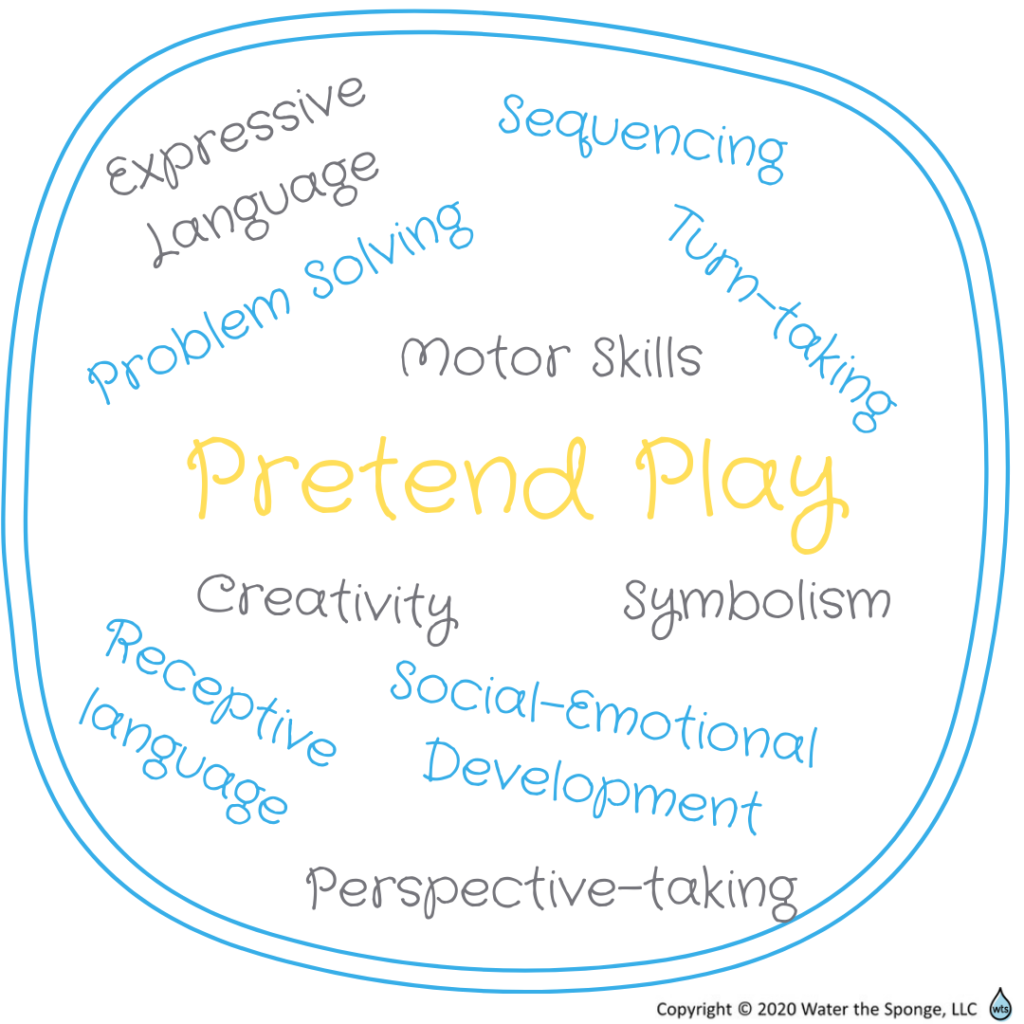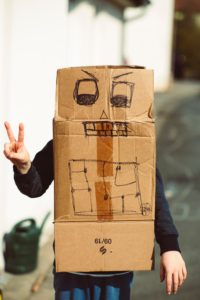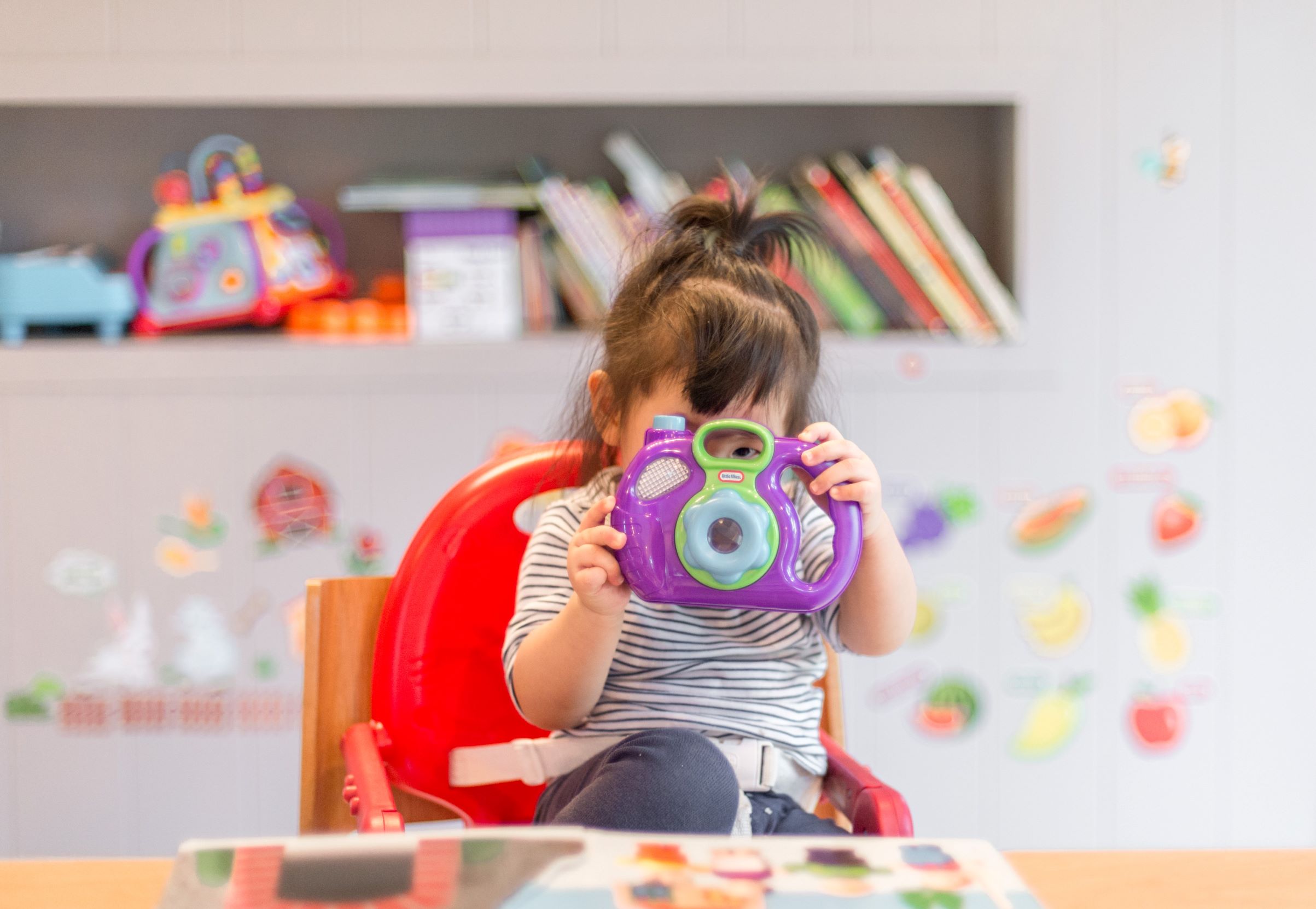There are many times that as a parent I find myself wanting to teach my children the “right way” or expose my children to the “right toys.” I think that it is only natural that as parents we want the best of the best for our children.
Sometimes I have to remind myself that the best thing to do is to let my children and their imagination take the lead. In my post about how to learn language through nature, I discussed three different approaches to teaching: clinician-directed, hybrid, and child-directed.
A quick refresher: clinician-directed means that the clinician controls the entire session. She picks out the activity, sets the boundaries, and directs the child on what to do. The client’s job is to focus on therapy and to follow the clinician’s lead.
In a hybrid model, the child has some say in what to do and so does the clinician. I frequently let my clients choose their favorite game or activity and then pair it with therapy materials.
When a session is client-directed, the child gets say over everything that is done in the therapy room and the clinician goes along with it. The clinician still teaches the client, but she does so in a natural, typically play-based, manner.
As a clinician, I typically fall on the hybrid part of the spectrum and try to let my clients feel as though they have some control over the session.
As a parent, I find myself engaging in child-directed play on a daily basis, especially during Covid times. My youngest is really starting to get into pretend play and I love getting down on the ground with him and engaging with him!

WHAT IS PRETEND PLAY?
Pretend play takes many forms. When you sit down with your child and imagine that you are in another world, play dress-up, re-enact everyday routines, or play with dolls, these are all examples of pretend play.
Do you remember a time when you were growing up that you engaged in pretend play? What made it special? What did you like about your time using your imagination?
For me, I was really into Barbie dolls! I had a three-story house for my dolls that I used all of the time. My older brother sometimes joined me and pretended to be the Ken doll. We would play a game that we invented called “Super Ken,” where I would throw Barbie off of the roof, and “Super Ken” would have to fly quickly to catch her!
I give this as an example, not only because it is a fond memory of my childhood, but because it demonstrates that there is not a “right way” to engage in pretend play. I think it is crucial for parents to remember this point, that there is oftentimes not a “right way,” rather, just “a way.”
While the method of pretend play may differ from person-to-person, the skills that are being acquired are essentially the same. What are those skills, exactly? I am glad that you asked because I am getting to that soon.
WHEN SHOULD I EXPECT MY CHILD TO ENGAGE IN PRETEND PLAY?
Every child develops at his or her own speed, with some children engaging in pretend play as young as 14-months, however, the average range is 18- to 24-months-old. Some children might demonstrate an interest in pretend play at a younger age and other children might be slightly older when they develop an interest in pretend play. The chart below summarizes various stages of pretend play given a certain developmental age.

What can you do if your child is 24-months-old and not showing interest in pretend play?
- If you ever feel in your gut that something is amiss in regard to speech and language development, my first recommendation is always going to be to consult with your pediatrician and ask for a referral to a speech & language pathologist.
- Make sure to model pretend play at home.
- Offer plenty of opportunities for pretend play in your house.
- For additional recommendations of ways to engage in pretend play with your little one, jump ahead to Let’s Water the Sponge!
WHY IS PRETEND PLAY IMPORTANT?

Pretend play is vital to childhood development for myriad reasons. The graphic above displays many of the skills that pretend play nurtures. Each one of these skills is a necessary part of development. While multiple posts could be written about each skill, I want to give you a snapshot of what each skill is, just so we can be on the same page.
| Skill | Definition |
|---|---|
| Expressive Language | The ability to communicate thoughts and ideas with others through speech, writing, or other means. |
| Receptive Language | The ability to comprehend language through auditory or written means. |
| Motor | Motor skills refer to gross and fine motor skills, using the whole body in a coordinated manner or strengthening muscles in isolated parts of the body. |
| Social-Emotional | Having an awareness of one’s own feelings and communicating them in a socially appropriate manner, in addition to developing an understanding of the feelings of others. |
| Problem Solving | Thinking about a problem from multiple angles, processing the solutions, and selecting the one that renders the best result. |
| Perspective-Taking | Thinking about a situation from another person’s point-of-view and understanding that person’s thoughts and feelings on the matter. |
| Creativity | The ability to think outside of the box and exercise that skill across multiple situations. |
| Turn-Taking | Trading off with one or more persons in an activity, game, or task. |
| Symbolism | Understanding that an object or picture can represent a different object, picture, or idea in a figurative or non-literal manner. |
| Sequencing | The ability to put numbers, letters, pictures, or events in an orderly manner. |
Thinking back to the example that I gave earlier, “Super Ken” was a silly game, but it is important to think about what skills my brother and I gained from this interaction.
First of all, it built social-emotional and turn-taking skills as we had an opportunity to interact with one another. We also worked on sequencing – knowing that I would toss Barbie off of the roof and then he would catch her. It was creative as I can’t say I have encountered anyone else who played this game at home (if you played this game, let me know in the comments!) This was a great game for hand-eye coordination and motor development, particularly for my brother as he needed to catch Barbie with as close to 100% accuracy as possible. Finally, this game helped us work on problem-solving – what if one of us wanted to play the game differently, or play something else entirely?
Keep fostering your child’s ability to use his or her imagination at home! The skills that are developed through pretend play are vital life skills, so be sure to continue to offer ample opportunities to engage in pretend play. If you’re in need of some ideas of things you can do, keep reading because that is coming up next!
LET’S WATER THE SPONGE!
I want to preface this by saying that there are countless ways to participate in pretend play at home! Remember that with pretend play, there is not a “right way” to do it and anything goes!
The most important thing is to model some ways to partake in pretend play. Do not hand your child a box of toys and expect him or her to just start pretending. Here are four easy ways to engage in pretend play in the classroom or home:
1.) Dress-up
You can create a “Dress-up” box in your house with old costumes, shirts that are too big, and other accessories from around the house. Buy some capes and masks so that your children can pretend to be super-heroes, or try to make your own using old t-shirts.
Get into the spirit of things and try dressing up with your child! Or, set the scene and help your child think through some people or pets they could be saving. For instance, if your child dresses up as Superman, create situations for him to be the hero. Pretend to create a blockade using pillows and hide some figurines inside. Have your child lift the pillows using his or her strength to save the toys.
Alternatively, pretend that a train is going to fall off of a track. Ask your child, dressed as Superman, what he can do to save the train! Should Superman fix the track? Pick up the train? Try to fly with all of the people on his back?
When your child is done being Superman, he or she can dress up as someone else and you can let the fun begin again!

2.) Make-Believe with a Box
You can do practically anything with a box! Plus, I know that many of you are probably sitting on mountains of Amazon boxes. You can turn them into a boat, train, rocketship, or fort for starters!
Recently, our children turned a huge box into a small “house” and they like to take their glow-in-the-dark dinosaurs in there and pretend to make them march around to the song, “We are the Dinosaurs” by the Laurie Berkner Band. Sometimes we pretend to build a community with the dinosaurs, or we have the dinosaurs pretend to make art projects, or clean the house.
If you want to try something super simple, put your child in the box with some crayons and let his imagination run wild! Be careful if your little one puts everything into his mouth – make sure to watch him carefully!

3.) Pretend to Make the Child’s Favorite Food
What does your child love to eat the most? Ice cream? Cookies? Pizza? Or smoothies like my oldest?
Whatever your child likes the most, try to re-enact creating that food with some toys and items around the house. This kind of activity taps into your child’s creativity, motor skills, sequencing, and language skills.
If your child’s favorite food is pizza, try using an old box as a pretend pizza box. Cut out pizza crust in the shape of a circle or square out of construction paper, and cut out some toppings using other colors of construction paper. Assemble it in the correct order, then pretend to bake the za in a make-shift oven! (I used to put pretend food underneath a chair in therapy when I didn’t have a play kitchen available in my office.) When it’s done, pull it out, cool it off, and serve it up to “eat!”
4.) Never underestimate the power of stuffed animals and dolls
Is your child an only child? Or perhaps he has siblings who aren’t interested in playing with him. If that’s the case, have a stuffed animal join you on your adventure!
Pretend to go on a safari adventure and talk about the different kinds of animals you will find. What will you need to pack for your outing? Think about what you will need to wear and how you can set-up your house to look like a safari. Have your child’s stuffed animals play along and join in on the adventure. Take turns spotting various creatures in your surroundings!

What kinds of fun and silly things have you done at home? What kinds of games has your child created through pretend play? Have you been on any adventures?
As my oldest likes to tell me before he shuts the door to the closet, “I’ll be right back, I’m just going to blast off and get a little snack!”


